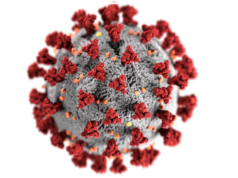
Clifford Weiss (Division of Interventional Radiology, Johns Hopkins University School of Medicine, Baltimore, USA) called for a prospective randomised controlled trial to investigate potential weight loss after left gastric artery embolization (LGAE) in patients with obesity at the GEST Symposium (Global Embolization Cancer Symposium Technologies; 9–12 May, New York, USA) earlier this year. While he concluded that non-randomised trials report a statistically significant and clinically important post-procedural weight loss after the procedure, he says that, given the “limited data” available to interventional radiologists, better quality data are needed to confirm the efficacy of LGAE as an enabler of weight loss.
Weiss first defined the patient population in which he believes LGAE may be most beneficial. For patients with a body mass index (BMI) over 40, who are classed as “severely obese”, he says gastric surgery is an appropriate choice, whether open or laparoscopic. For patients with a BMI between 25 and 30, “a lot of options are available”, according to Weiss, such as dietary changes and exercise. A treatment gap exists, therefore, for patients with a BMI of 30–40.
Before detailing the current evidence in favour of LGAE as a solution interventional radiologists may provide for these patients with intermediate obesity wanting to lose weight, Weiss insists that no “mechanical solution” will be the ultimate obesity treatment. “Any of these solutions […] may only serve as part of the solution”, he tells the GEST audience. “Nothing is going to replace surgery as the gold standard in the population of patients who have severe obesity. More than anything, [LGAE] will be a tool for motivation, or to decrease hunger, or maybe as a standalone tool for limited weight loss”. He also emphasised the psychological, genetic, environmental, sociocultural and behavioural elements of obesity, and the consequent need for an interdisciplinary approach to treatment.
Theoretically, the goal of LGAE is to remove hormone-producing cells from the blood. “Although this has not been fully proven,” said Weiss, “we believe ghrelin, the hunger stimulating hormone, is critical to this process.” By embolizing the left gastric artery, interventional radiologists hope to alter the balance of hunger and satiation hormones. Preclinical studies in both swine and dog models have demonstrated that the procedure leads to a decrease in ghrelin and either a decrease in weight gain or an increase in weight loss.
Following preclinical studies, there have been multiple retrospective studies looking at LGAE in humans, as well as a few prospective single arm trials. The most recent of these Weiss mentioned to the audience was conducted by Mohamed Zaitoun (Department of Radiodiagnosis, Zagazig University, Zagazig, Egypt) et al, and published in the June issue of Journal of Vascular Interventional Radiology (JVIR). Zaitoun and colleagues found that LGAE is well tolerated and leads to clinically significant decreases in weight and glycated haemoglobin in obese, prediabetic patients. They reported a 9.4kg or 8.9% mean weight loss at six months (p<0.0001) and no complications.
Adding to this evidence, Weiss mentions his own physician sponsored IDE (investigative device exemption) single-arm, prospective clinical trial on 20 patients with severe obesity. All participants had a BMI over 40, and were lighter than 400Ibs. They were embolized with 300–500µm Embospheres (Merit Medical). The primary endpoints were weight loss and 30-day adverse events. Weiss reported no major adverse events in this study population, and a minor adverse event in 27% (eight of 20) of the patients. At 12 months, there was a mean weight loss of 16.8kg, or 6% of initial body weight. The mean excess weight loss was 11% at one year (p<0.01).
Describing a graph showing hunger and weight loss over time, Weiss elaborated: “Interestingly, the hunger dropped very acutely and then started to rise again. The weight loss continued, but then lagged behind [the change in hunger]. The hunger started to reverse [appetite increases] at the 13-week time point and then slowly afterwards the weight loss started to decrease as well. So hunger and weight change go hand in hand. Could this be a motivating procedure [to add to] already existing weight loss protocols?” he asked.
Weiss’ residents conducted a meta-analysis to see if they could detect predictors of weight loss after LGAE. They did a systematic literature search to identify studies that reported post-procedure weight changes and, after excluding studies performed for the primary purpose of treating malignancy, ended up with seven publications to examine. From their analysis, which Weiss shared with the GEST attendees, they determined that the most common adverse events were transient abdominal pain and superficial gastric ulceration. The pooled results of the seven studies revealed a mean body weight loss of 8.73% and a mean absolute weight loss of 10.08% (p<0.001 for both figures).
Younger age, female sex, and higher baseline ghrelin levels appeared to be positive predictors of post-procedure weight loss, according to this meta-analysis.
However, Weiss reiterated that interventional radiologists still have “a lot to learn” about this procedure. “This needs randomised controlled data, this is not ‘good to go,’ and this is not yet ready to be conducted in patients. There are a lot of data that we still need to collect, which must be collected in a unified and thoughtful way so that we can actually move this forward, or not, depending on if it really works,” he insisted. Nevertheless, he ended on an optimistic note: “I believe in data, and I believe that our data so far is promising.” gastric












